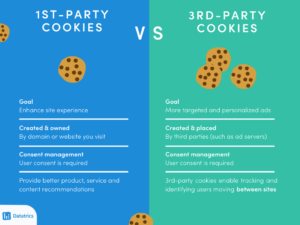
Difference between First-party cookies and third-party cookies.
First-party cookies and third-party cookies are terms that refer to different types of cookies based on their origin and the relationship between the user, the website they are visiting, and other external entities. Here’s a breakdown of the differences between first-party and third-party cookies:
- Origin:
- First-Party Cookies: These cookies are set by the website that the user is directly visiting. The domain in the cookie belongs to the website itself. First-party cookies are primarily used to enhance the user experience by remembering user preferences, login information, and other settings.
- Third-Party Cookies: These cookies are set by domains other than the one the user is currently visiting. They often belong to third-party advertisers, analytics services, or social media platforms. Third-party cookies are commonly used for tracking user behavior across different websites.
- Purpose:
- First-Party Cookies: Primarily used for improving user experience on the specific website. They can remember user preferences, maintain user sessions, and store other site-specific information.
- Third-Party Cookies: Mainly used for tracking and collecting data across multiple websites. Advertisers and analytics services use third-party cookies to gather information about user behavior, interests, and demographics.
- Privacy and Security:
- First-Party Cookies: Generally considered more privacy-friendly because they are directly controlled by the website the user is interacting with. They are subject to the privacy policy of that specific site.
- Third-Party Cookies: Have raised privacy concerns because they enable tracking across different websites, creating profiles of users’ online activities. As a response to privacy concerns, many web browsers have implemented measures to limit or block third-party cookies.
- User Control:
- First-Party Cookies: Users have more direct control over first-party cookies through browser settings. They can choose to block or allow them as per their preferences.
- Third-Party Cookies: Due to privacy concerns, many browsers and privacy-focused tools offer options to block third-party cookies. Users can control their acceptance through browser settings.
- Examples:
- First-Party Cookies: Session cookies that keep a user logged in, language preferences, or items added to a shopping cart on an e-commerce site.
- Third-Party Cookies: Cookies from advertising networks, social media buttons, or analytics services that track user behavior across various websites.
In recent years, there has been a growing emphasis on user privacy, leading to changes in browser policies and increased awareness regarding third-party tracking. Some web browsers have implemented measures to restrict or block third-party cookies, contributing to ongoing discussions about the future of online tracking and advertising technologies.

Image source : Datatrics
